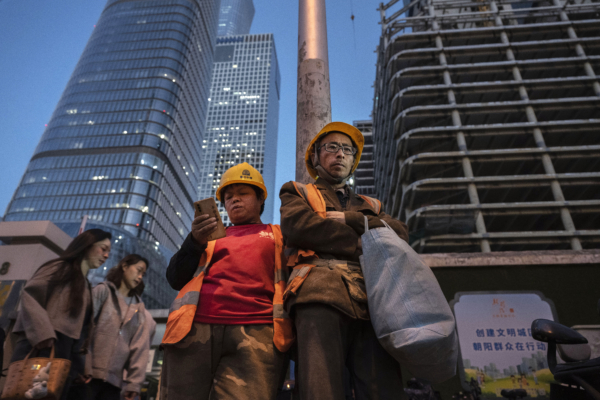China is currently experiencing its longest period of currency tightening since the Great Leap Forward in the 1960s. There are no signs of a reversal in the situation in 2025, despite a slight seasonal increase in holiday consumption. Prices in the industrial and retail sectors continue to be weak, with China facing its third consecutive year of currency tightening.
Bloomberg analysis shows that the actual deflation experienced in China is more pronounced than official figures suggest, with daily commodity prices plummeting and the proportion of loss-making enterprises reaching the highest level in 25 years.
Currency tightening reflects an imbalance between supply and demand in the economy. The sluggish real estate market in mainland China has led to a reduction in people’s assets, with supply far exceeding demand, damaging business interests. This has led to layoffs, wage cuts, a decrease in consumer spending, reduced corporate expenditure, a slowdown in economic activity, increased debt burdens, and further exacerbation of currency tightening.
This vicious cycle is known as the deflationary spiral, which once formed continues to strengthen itself.
Moreover, once negative expectations of deflation are formed, various stimulus measures are likely to be ineffective. Eswar Prasad, a professor of trade policy and economics at Cornell University and former head of the International Monetary Fund (IMF) in China, told Bloomberg, “The longer deflation persists, the deeper people’s negative expectations of the economy, and economic stimulus measures become increasingly ineffective.”
This trend will also have global implications: China’s cheap export goods may depress overseas prices, exacerbate friction with trading partners, and impact multinational companies.
In response to the deflation, corporate operators are also struggling. In the past five years, the proportion of “zombie companies” (enterprises unable to pay interest on debt) has risen from 19% to 34%. Capital and research and development expenditures of most companies have decreased, marking the first occurrence of this in a decade. Over a third of companies in various industries laid off employees in 2024.
The proportion of loss-making companies is at a new high in 25 years, with an analysis by Bloomberg of around 6,000 Chinese listed companies indicating that falling prices, expanding losses, and declining profit margins are putting pressure on private enterprises. Many companies attribute their losses to weak demand and price wars.
Facing the “internal circulation” of prices, Beijing has begun cracking down harshly on excessive competition, temporarily increasing raw material prices. However, due to decreased consumer demand and the continued slump in the real estate market, experts doubt whether these government measures can be effective.
Many international names have announced selling or adjusting their businesses in China as part of a recent exodus of foreign investment from the Chinese market. Starbucks has sold 60% of its retail business in China, while Burger King has reached a joint venture agreement with Chinese private equity fund CPE, which will acquire an 83% stake. Others like McDonald’s, Carrefour, Dell, Samsung, Amazon, IBM, and Micron have also been pulling out or adjusting operations in the mainland market.
According to data released by the Ministry of Commerce of China, the actual use of foreign investment in China was 573.75 billion RMB by the first 9 months of 2025, a 10.4% decrease compared to the previous year.
The pressure is not just limited to companies but also affecting employee salaries, which in turn impacts demand. Last year, the wage growth rate of private enterprises, which employ over 80% of China’s urban workforce, hit a historic low. In industries such as manufacturing and information technology, private enterprise wages in official statistics decreased for the first time. An analysis of private sector wages in 38 cities from 2022 to 2024 showed an average decline of 5%. Even in China’s “new economy” sectors such as artificial intelligence and new energy, entry-level salaries have dropped by 7% from their peak in 2022.
Meanwhile, Chinese household savings have increased to around 110% of last year’s gross domestic product, hitting a historical high, indicating that consumers expect future price decreases, leading to increased economic uncertainty.
According to a report by Bloomberg, individuals like 38-year-old Guo Fang are feeling the impact. She was once a technology worker in Shanghai, enjoying a high income exceeding $281,000 annually with her husband. However, after leaving her job to have a child in 2020 and attempting to re-enter the workforce, her former colleagues who promised to help her find a job have now been laid off. Her husband, an engineer in the automotive industry, is also worried about the company’s struggles in price wars, facing potential salary cuts.
“This year we have cut back on some family trips because my husband is worried about his job,” she said. “Now when I book hotels, I consider whether I should choose cheaper options. This is the first time in years I feel the need to cut back on expenses.”
Zhū Tiān, deputy dean and economics professor at the China Europe International Business School, believes that China is running out of time to break free from the deflationary spiral. If private consumption does not improve, the economy will face a crisis.
“If we look at history, deflation is very rare,” he said. “If prices fall for three years, inflation does not rebound, people will believe that inflation will not come back, and China will soon become like Japan.”
Since World War II, except for Japan, there have been very few major economies experiencing prolonged deflation. Japan gradually moved away from a long period of low inflation and deflation since the 1990s after 2022, with prices gradually stabilizing. The United States, after experiencing a period of high inflation following the pandemic, currently maintains a moderate level of inflation.
However, China is now facing deflation. The growth of income and real estate since the 1980s had once sparked hopes of upward mobility, but now, deflation is eroding confidence among the Chinese people.
(Report referenced Bloomberg)

